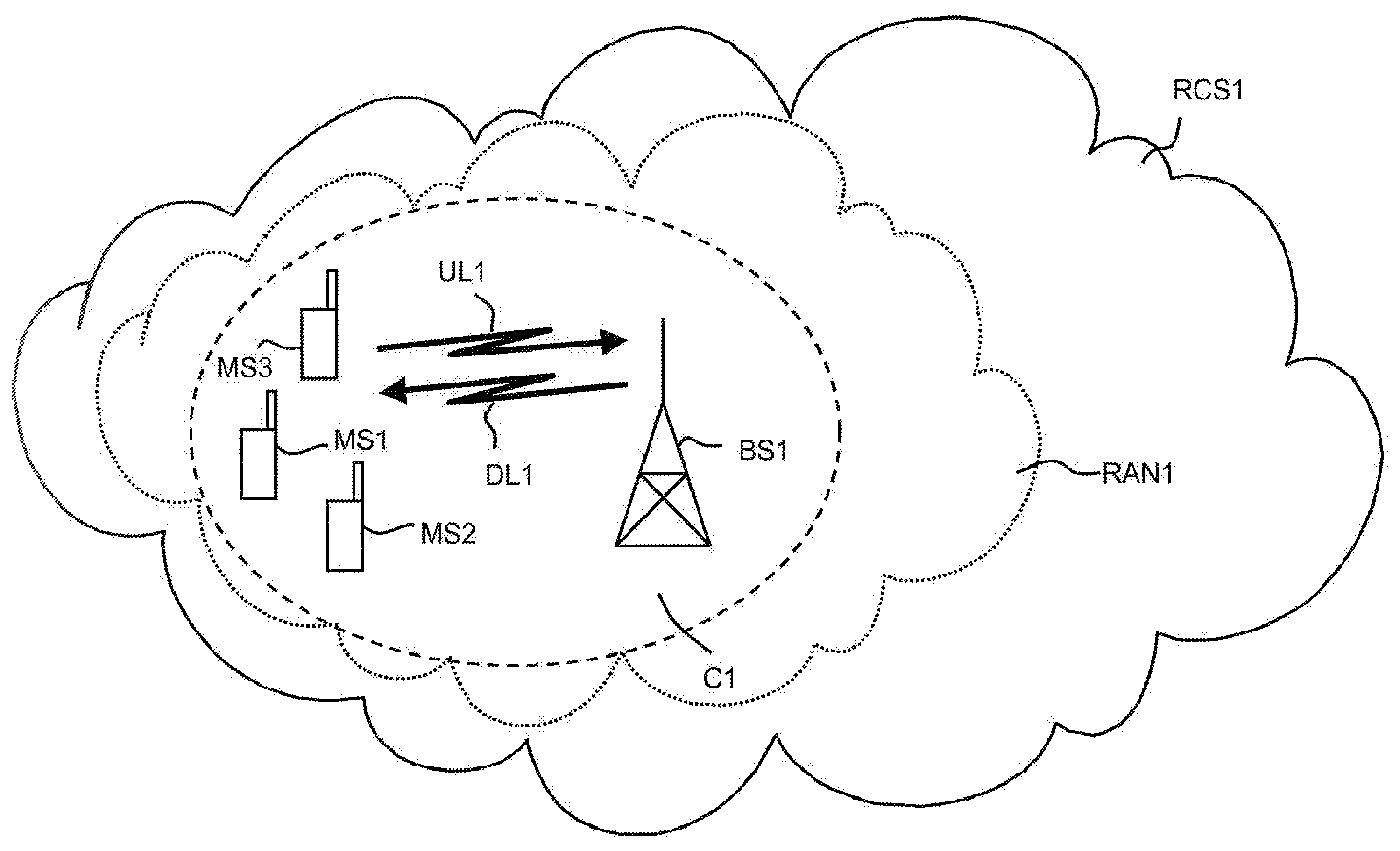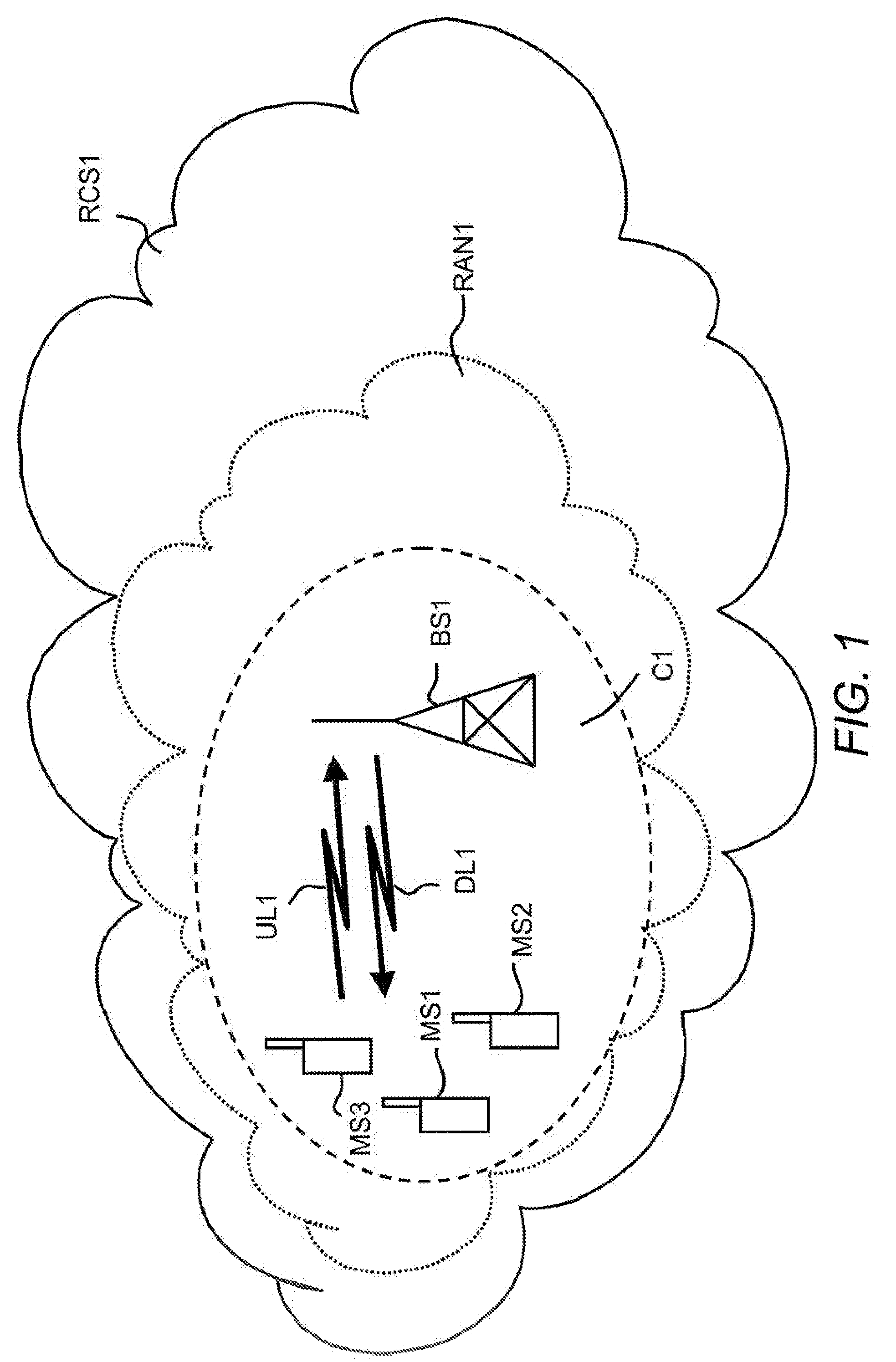Method for building sets of mobile stations in MIMO systems, corresponding mobile station, base station, operation and maintenance centre and radio communication network
a technology of mobile stations and mimo systems, applied in the field of building sets of mobile stations in radio communication networks, can solve the problems of consuming a considerable amount of the maximum uplink capacity of a radio cell, and reducing considerably the overhead, so as to reduce the overhead. the effect of reducing the overhead
- Summary
- Abstract
- Description
- Claims
- Application Information
AI Technical Summary
Benefits of technology
Problems solved by technology
Method used
Image
Examples
first embodiment
[0045]The first computer readable program PROG1 is foreseen for executing steps of the method according to the invention. The first CPU CPU1 is foreseen for executing the first computer readable program PROG1.
[0046]Referring to FIG. 3 the first mobile station MS1 of FIG. 1 contains a second antenna system AS2, a second transceiver TR2, a second CPU CPU2, and a second computer readable medium MEM2.
[0047]The second antenna system AS2 contains a fourth antenna element AE4 and a fifth antenna element AE5. The second antenna system AS2 can also contain more than two antenna elements for reception and / or transmission. But this is not shown for simplification.
[0048]The fourth antenna element AE4 and the fifth antenna element AE5 are used for the first downlink channel DL1 and the first uplink channel UL1. Alternatively a further antenna element can be used to split downlink and uplink transmission on different antenna elements.
[0049]The second transceiver TR2 receives the first reference s...
second embodiment
[0092]FIG. 7 shows a method M2 for use in the first radio communication system RCS1. The method M2 will be used as an improvement according to the invention, if a parameter describing the angular beam spread is below a first threshold value of within a first range of values. The angular beam spread depends on the inter-beam interference of the downlink beams DB1, DB2, DB3, and DB4. The parameter can be derived for example from the CQI values reported by the mobile stations MS1, MS2, and MS3.
[0093]The steps shown in FIG. 7 that correspond to the steps of the FIG. 5 have been designated by same reference numerals. In addition to the steps M1 / 1, M1 / 2, M1 / 3, M1 / 4, M1 / 5, M1 / 6, M1 / 7, M1 / 8, and M1 / 9 performed in the first embodiment of the invention, in the second embodiment of the invention following step M2 / 1 is performed after the step M1 / 8 and either the step M1 / 9 or step M2 / 2 is performed after the step M2 / 1.
[0094]In the further step M2 / 1 the first base station BS1 compares the parame...
third embodiment
[0099]It is a further improvement according to the invention to adapt a selection of transport formats for the mobile stations of the mobile station set according to the use of the minimum beam distance method. Such adaptation should account for a transmit power split to multiple downlink beams.
[0100]FIG. 8 shows a method M3 for use in the first radio communication system RCS1 according to the third embodiment of the invention. The elements shown in FIG. 8 that correspond to elements of the FIG. 7 have been designated by same reference numerals.
[0101]In addition to the steps M1 / 1, M1 / 2, M1 / 3, M1 / 4, M1 / 5, M1 / 6, M1 / 7, M1 / 8, M1 / 9, M2 / 1, and M2 / 2 of the method M2 following step M3 / 1 is performed after the step M2 / 2.
[0102]In the further step M3 / 1, the first base station BS1 selects a transport format for each mobile station of the mobile station set according to the reported CQI values and according to a PSF parameter (PSF=power split factor). The PSF parameter is used because multiple d...
PUM
 Login to View More
Login to View More Abstract
Description
Claims
Application Information
 Login to View More
Login to View More - R&D
- Intellectual Property
- Life Sciences
- Materials
- Tech Scout
- Unparalleled Data Quality
- Higher Quality Content
- 60% Fewer Hallucinations
Browse by: Latest US Patents, China's latest patents, Technical Efficacy Thesaurus, Application Domain, Technology Topic, Popular Technical Reports.
© 2025 PatSnap. All rights reserved.Legal|Privacy policy|Modern Slavery Act Transparency Statement|Sitemap|About US| Contact US: help@patsnap.com



